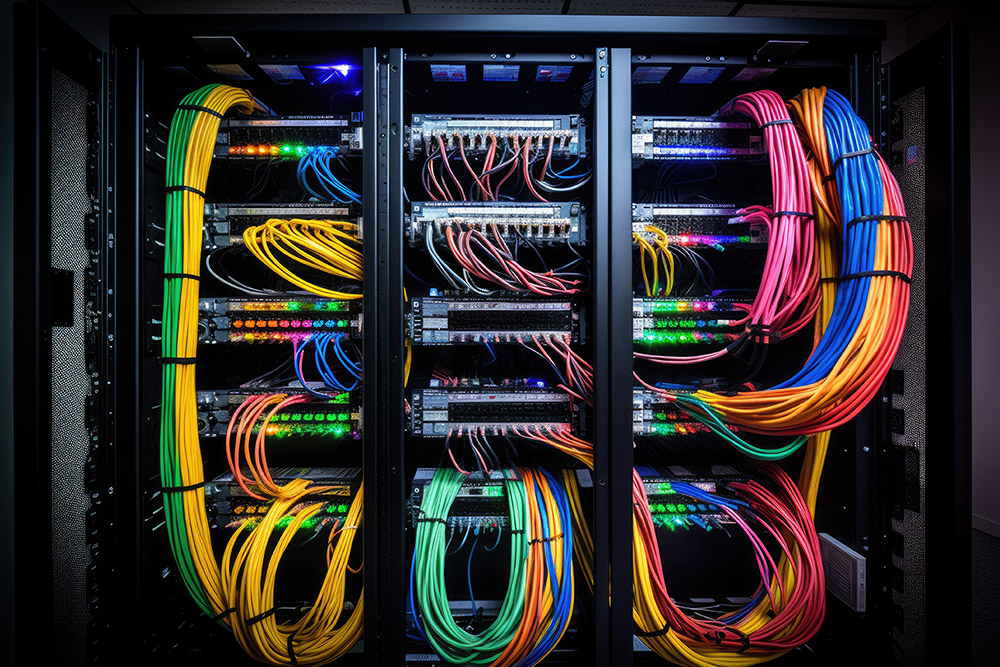Five hundred billion dollars in capital investment over the next four years. This is the expected investment by NVIDIA to manufacture AI supercomputers and Blackwell chips in the United States. Although this single project is at a mind-boggling scale, it is one of many high-dollar projects announced in recent years that are changing the data center landscape across the U.S. But the world of data center development is multifaceted, involving numerous supply chain industries that systematically integrate with these massive investments. While these ambitious developments make eye-catching headlines, we should also be noting the lesser known, yet significantly impactful, technological advances coming from companies you may not immediately associate with data centers.
As cloud computing continues to revolutionize business operations, innovation, user experiences, and technology itself, the importance of the data centers that underpin this intricately robust digital infrastructure cannot be understated. Simply put, data centers are where the internet lives, and all activity that involves the internet relies on these structures. Their expanding importance in the framework of our society is reflected in their becoming a household term in recent years. With this increasing familiarity of the industry, discussions surrounding new data center development usually involve concepts like energy use, water, and sustainability. While these certainly are pressing topics, it is perhaps more critical to consider the diverse ecosystem of distribution and supply chain operations that integrate with data center development and its growth trajectory.
The Role of Data Centers
Data centers play an integral role in the way we experience our day-to-day activities. They allow the cloud to operate and thus facilitate our use of key applications like Dropbox, Google Drive, Netflix, and Microsoft 365. Meanwhile, they are instrumental in routing internet traffic, acting as central hubs through which internet traffic perpetually flows. Additionally, the exponential rise of AI and machine learning requirements fuel an ever-increasing demand for data centers and the industry’s supply chain. All in all, our daily lives are increasingly more reliant upon data centers and the supporting ecosystem.
$500B
To underscore the importance of this industry, let’s look at sports and how we watch our favorite athletes and teams. Without data centers, there would be no Masters. No March Madness. No Major League Baseball. No National Basketball Association. No National Football League. No National Hockey League. No Major League Soccer. No NASCAR. On game day, sports fans are not likely concerned about data centers and whether they will be reliably operating without any interruption. But if data centers were to cease operations, all of the media coverage, fan attendance, and sports betting that comes with it would come to a halt. Ticketing, access control, and event logistics would shut down. In other words, not one of these sporting events could happen in the modern world without data centers and all the supporting companies that make data centers operate reliably.
To examine this concept within the world of sports more closely, let’s take a deeper dive into the viewers’ experience of the Masters. Every shot every player takes can be streamed on demand. Masters.com and the Masters app allow viewers to stay current via live coverage. AI ball tracking tech, real-time leaderboards, shot visualizations, swing analysis — all of these tools rely on data centers. The Masters, as all sporting events have become in our modern world, is a tech-driven, immersive enterprise, totally reliant upon the many thousands of companies that support the data center supply network.
Sports are just the tip of the iceberg. Nearly every modern industry heavily relies upon the data center ecosystem. While we work from our home office or from an airplane seat at 30,000 feet, file our taxes, pay our bills, place our grocery delivery order, hail an Uber, or sit in our recliner streaming the latest episode of “The White Lotus,” we actively (although rarely realizing it) are totally dependent upon data centers and their supply chains.
The Data Center Supply Chain
Data centers could be described as large industrial buildings (similar to what you might see in any modern industrial park or distribution center) with massive servers storing pictures of your daughter’s first steps, your tax returns, banking statements, text messages, and that one time you sent a voice memo to your friends singing “Don’t Stop Believin’.” But they are much more than places to store this type of vital information.
As people think about a data center’s physical properties, the first thing most consider are the rows of servers and the miles of cables. While these are certainly important components of the industry, the robust power infrastructure secured through uninterruptible power supplies and backup generators, the building’s physical infrastructure, their complex cooling systems, racks and enclosures, and sustainability infrastructure are lesser known but equally valuable components. Below, we have compiled a number of key elements found within the data center supply chain, and we have highlighted a few of the primary enterprises that serve this industry.
The demand for more capacity is outpacing general contractor labor resources.
Uninterruptible Power Supply
Data centers often demand a considerable amount of electric power supply. Some data centers require more than 100 megawatts, enough to power tens of thousands of homes. Importantly, much of this demand must be met with reliable uninterruptible power to protect against any reduction of operational and maintenance activities. To accommodate this critical need, companies like Schneider Electric, Eaton, ABB, Toshiba, and Mitsubishi Electric manufacture uninterruptible power supplies (UPS). Such systems provide near-instantaneous short-term protection from power outages via battery power. TMEIC, a joint venture of Toshiba and Mitsubishi Electric, recently announced plans for a new uninterruptible power supply assembly facility in the Houston, Texas, area to serve their rapidly growing data center clients.
Backup Generators
While UPS systems provide instantaneous battery backup during power outages, their power supply lasts for a few minutes to a few hours. On the other hand, standby generator sets provide a much longer backup solution, lasting from a few hours to a few days. In mission-critical backup power systems, UPS systems and standby generator sets are usually coupled together, with the gensets required to pick up full load in under 10 seconds. Roughly the size of shipping containers, these 2.5-megawatt-plus, typically diesel, generators are an essential part of the supply chain for data centers. Cummins, Caterpillar, and Rolls-Royce are the three largest suppliers of generators in this space, and business is booming and growing.
Regionally headquartered in Novi, Michigan, Rolls-Royce Solutions America is part of the Power Systems division of the United Kingdom-based Rolls-Royce Group. Its U.S. manufacturing locations include its mtu engine production facility in Aiken, South Carolina, and a dedicated mtu power generation system facility in Mankato, Minnesota. In its 2024 annual results announcement, Rolls-Royce reported that the largest increase in sales for its Power Systems division was in its backup power systems business, which grew by 25 percent overall and by as much as 46 percent for backup power systems for data centers.
Having served the hyperscale data center market for more than 15 years, Rolls-Royce has become an essential player in the overall ecosystem, and the company expects to see demand from the industry for its power generation systems double in the next three years. Accordingly, it is planning strategic investments to support that growth.
“Although the rise in data center demand has been occurring for more than a decade, the COVID-19 pandemic was a catalyst for the exponential growth in data center deployment as interaction with the outside world moved online and to virtual platforms,” said Kevin McKinney, director of power generation sales for Rolls-Royce in the Americas. “The cloud computing market has continued to grow for a number of reasons including the tremendous rise in AI applications and the trend of server racks growing in power density.”
The rise in data center demand has been occurring for more than a decade, but the pandemic was a catalyst.
Rolls-Royce is currently contemplating an expansion of its existing U.S. footprint, which would lead to a notable growth in its American workforce and investment into the U.S. Moreover, the company’s increase in production would have ripple effects across its supply chain.
“Rolls-Royce has a history of investing in its capabilities and facilities in the U.S., and that applies to our supply base as well,” said McKinney. “The significant increase in production that will be required to meet the demands for our products will mean greater engagement with the supply chain and strengthening local supply of components and raw materials to produce local for local as much as possible.”
Fiber Optic Cabling Solutions and Connectivity Systems
One company that is feeling the ripple effects of increased production while also driving the industry forward in its own right is Corning. Well known as a fiber optic cabling solutions and connectivity systems supplier, Corning is at the forefront of generative AI, which continues to be a major driver for the insatiable desire for new data centers across the developed world. Corning estimates the construction of up to 70 new hyperscale data centers each year in the U.S. as a result of generative AI, taking the number of data center hubs in the U.S. from six to more than 12 by 2030.
“The demand for artificial intelligence changes the game for data centers,” Mike O’Day, senior vice president and general manager of Corning Optical Communications, wrote in a blog post last year. “Emerging AI data center network architectures represent a step change in passive optical content in the data center …”
The growth of Generative AI is impacting data centers and the long-haul networks that connect them. Fiber is critical to both: Inside the data center, Gen AI is requiring ever-larger clusters of Graphics Processing Units (GPUs) that require high-density fiber connections. Regional AI data center hubs also need to be connected to each other with fiber. Corning this year launched its new Glassworks AI portfolio of fiber, cable and connectivity solutions to meet these needs. Corning owns and operates two of the world’s largest fiber and cable plants in North Carolina, and its Optical Communications headquarters is in Charlotte.
Servers
Perhaps the most fundamental component to a data center is the server. Servers store data, process requests, and deliver upon those requests. Data centers typically have thousands, sometimes tens of thousands of servers arranged in racks. Such servers make up the “cloud.”
The largest global manufacturers of servers are Dell, HP, Lenovo, and Cisco. One of Lenovo’s two headquarters is in the famed Research Triangle Park in Morrisville, North Carolina. The company recently announced new solutions that will accelerate data center modernization with up to 6.1 times higher computer performance than the previous generation.
More broadly, the data center server sector is expected to reach $82.1 billion by 2033, according to a 2024 report by IMARC Group.
Cooling Systems
Like the heat generated by your personal laptop or desktop computer, servers used in data center facilities require cooling systems to prevent overheating that would otherwise lead to failure. A room full of operating servers, running 24 hours per day, creates a substantial amount of heat that needs to be dissipated, effectuated typically through complex “non-contact” water systems. Companies like Gates Industries, Microsoft, and ThermalWorks have demonstrated innovative ways to address the data center ecosystem’s cooling needs.
Emerging AI data center network architectures represent a step change in passive optical content in the data center.
Gates recently announced a new product focused on cooling solutions for the data center industry called the Data Master Data Center Cooling Hose. This product incorporates flexible and durable materials for easy routing in complex configurations and ensures compatibility with a wide range of coolant fluids. Meanwhile, Microsoft has proposed a closed-loop design that manages temperatures via a water recycling process that continually circulates water between servers and chillers. Alternatively, ThermalWorks offers an entirely waterless option that incorporates a fully integrated rooftop chiller unit optimized for high-density workloads and low energy consumption. In March 2025, the company announced the launch of a supplemental advanced heat recovery technology as a standard option for its 1-megawatt and 2-megawatt waterless chiller plants.
Construction
The rapid growth of the industry is directly impacting the construction industry as well. Globally, there are an estimated 11,800 data centers. The U.S. is home to the single largest concentration of data centers with more than 5,000 in the country. On a square footage basis, the data center industry is currently the top industry under development in the U.S.
Such rapid development requires a massive mobilization of the construction supply chain. According to Data Center World’s 2025 State of the Data Center Industry Report, “The number of data centers will increase over the next three years, from a current average of one to an average of six, a sixfold increase in construction for many operators.”
Kentucky-based general contractor Gray has a number of teams deployed throughout the U.S. The company is building small and large-scale data center facilities, including two data center buildings on QTS’s campus in New Albany, Ohio. According to the company, data center projects now present a sizeable percentage of Gray’s industrial portfolio, and the company anticipates additional growth. Nonetheless, the scale of data center projects and the number of simultaneous mega-projects under construction in close geographic proximity represent unique challenges for general contractors and their suppliers and subcontractors.
46%
“The demand for more capacity and the speed at which data centers are built is simply outpacing general contractor labor resources. Alternative delivery models and execution strategies are being discussed more frequently,” said Loni McCarron, senior manager for business development at Gray.
The difficulty in finding trade professionals such as electricians, carpenters, pipefitters, etc., is also becoming a growing concern for industrial development projects across the country. According to McCarron, “On a single hyperscale data center campus, our labor curve could peak at 1,000-plus on-site trades men and women. Partnerships are the key. This is particularly important as more data centers are built in tertiary and rural markets where skilled labor is limited.”
In June 2025, Schneider Electric announced plans to open a 105,000-square-foot integration facility in Red Oak, Texas, employing 200 workers. The project is focused on supporting the growing demand of AI data centers throughout the U.S. Schneider’s facility will manufacture the company’s EcoStructure Modular Data Center line of products.
In a recent public announcement of the project, Vandana Singh, senior vice president, Secure Power Division and Data Center Business for Schneider Electric, said, “As demand for data center solutions continues to soar, the inauguration of our new integration facility marks a crucial moment in our journey to redefine industry standards and empower businesses with transformative infrastructure solutions.”
“The Red Oak facility represents a pivotal step forward in expediting delivery timelines and enhancing operational efficiencies for customers across growing industries and segments, from cloud and service providers to semiconductors and electric vehicles to healthcare and telecommunications,” Singh said. The new facility in Red Oak, like many other recent investments by data center suppliers large and small, highlights how the industry relies on a vast array of interconnected products and services that collectively power our modern world.
Looking Ahead
The industry is not without its challenges. As the supply chain grows, the industry must continue to problem-solve and innovate to meet increasing pressures. According to AFCOM State of the Data Center for 2023, 94 percent of operators faced some form of supply chain issue, with 59 percent citing difficulties in procuring IT equipment like servers and switches, and 51 percent encountering problems obtaining power systems such as generators and UPS units. Further, concerns around power availability and infrastructure, tariffs and trade barriers, as well as talent shortages (electricians and engineers), are obstacles that must be overcome. Despite these challenges, the future is bright for product and service providers that make up the booming data center ecosystem, as well as for those communities that these companies call home. As global data center investments are projected to surpass $1.4 trillion by 2027, and suppliers are rapidly innovating to meet surging demand, the industry stands poised not only to overcome its current challenges but to build a more resilient, sustainable digital foundation for the future.
 W. Ford Graham, McGuireWoods Consulting
W. Ford Graham, McGuireWoods ConsultingW. Ford Graham is a senior vice president on McGuireWoods Consulting’s national infrastructure and economic development team and a partner with McGuireWoods. Ford has a depth of experience working in the economic development sector, where he has been one of the leading recruiters of international companies to the Southeastern United States. He has facilitated new industry and industrial expansion in over 123 projects, which have resulted in commitments of more than 11,000 new jobs and $3.9 billion in new investment. Ford’s practice focuses on companies opening or expanding operations in the U.S. In addition to economic incentives, Ford assists companies with the full spectrum of legal needs that arise when companies enter new markets.
 Steven Pearce, McGuireWoods Consulting
Steven Pearce, McGuireWoods ConsultingSteven Pearce is a vice president on our national infrastructure and economic development team, where he advises clients on complex, high-value projects across the country. He specializes in guiding companies through the stages of the site selection process, helping them navigate incentives, infrastructure and stakeholder engagement to bring major investments to life.
 Margaret Rockwell, McGuireWoods Consulting
Margaret Rockwell, McGuireWoods ConsultingMargaret Rockwell is a vice president on McGuireWoods Consulting’s national infrastructure and economic development team and serves as counsel with McGuireWoods LLP.
